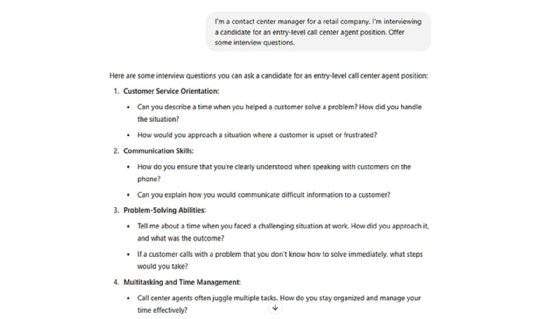
Getty Images/iStockphoto
How to use ChatGPT for customer service
Customer service teams can use ChatGPT to automate tasks, generate responses to customer inquiries, summarize email threads and power human-like chatbots.
ChatGPT can't single-handedly run a contact center, but it can lighten agents' workloads.
OpenAI's free chatbot tool, ChatGPT, initiated a wave of interest in generative AI (GenAI) technology after its public release in 2022. This type of AI has affected many areas of business -- especially those that rely on chatbots, such as contact centers. For decades, chatbots have let contact center managers reduce operational costs and offer 24/7 service. However, natural language easily confuses many of these service bots. ChatGPT, on the other hand, can understand complex language and engage more like a human.
Customer service teams can use ChatGPT in various ways, including the following:
- Use the free version -- or a higher tier, such as ChatGPT Plus or Enterprise -- to generate responses to customers' complaints and reviews, summarize past customer interactions, translate inquiries and create interview questions.
- Use OpenAI's API offering to train ChatGPT's underlying large language models (LLMs), including GPT-4o, on their knowledge base to create customer-facing chatbots and employee-facing AI assistants.
- Integrate customer service software, such as Salesforce and Zendesk, with OpenAI's models to enhance automation and customer support capabilities.
As contact centers debate whether to incorporate GenAI into their strategies, customer service leaders should understand how ChatGPT and other GenAI tools could help them improve customer service.
What is ChatGPT?
ChatGPT is a chatbot that can reply to a wide range of questions and prompts with human-like responses. OpenAI developed the tool and released a free version to the public on Nov. 30, 2022.
The free tier sits atop OpenAI's GPT-4o mini LLM -- a type of GenAI technology that its developers trained on billions of pages of text from the internet. Higher tiers, such as ChatGPT Pro, offer more advanced models, such as GPT-4o and OpenAI o1, which can improve speed and reasoning capabilities.
Unlike simpler chatbots, ChatGPT can understand language in context, remember past conversations and quickly generate creative content like poems, short stories, essays, articles and email responses. Many people use ChatGPT in their daily lives, but business professionals can also use it to automate work tasks.
8 ways to use ChatGPT for customer service
Contact center managers can use ChatGPT to reply to customer complaints and reviews, enhance customer-facing chatbots, summarize and translate inquiries and create AI assistants.
1. Reply to customer complaints and reviews
As service agents engage with customers on various channels, such as email, social media and product review websites, ChatGPT can help them quickly formulate responses to complaints and reviews.
For example, a service agent can ask ChatGPT to write an email response to an angry customer, and the chatbot will do it -- typically in the professional and empathetic tone that organizations expect their agents to use.

ChatGPT also lets users dictate the length of responses, which can help them craft short-form responses for social media and product review comments. For instance, a user could ask ChatGPT to write a response to a negative customer review in 500 characters or fewer.

Despite ChatGPT's ability to generate human-like responses, users still need to edit, personalize and fact-check responses. Developers trained the tool on internet data, so it contains biases and inaccuracies that can be found online.
Additionally, this tool doesn't have access to organizations' specific policies, so users must ensure responses don't promise discounts or other forms of compensation their organizations cannot offer.
2. Enhance customer-facing chatbots
Since the early 2000s, customer service departments have used customer-facing chatbots to help answer frequently asked questions, lighten agents' workloads and reduce hiring costs. However, most have been rule-based chatbots, which offer preprogrammed responses to limited sets of keywords and phrases. These chatbots function more like a Google search than a true conversation, and natural language easily confuses them.
Conversely, ChatGPT and other GenAI chatbots use advanced LLMs to engage in realistic dialogue. Although organizations cannot use ChatGPT itself as a customer-facing chatbot, OpenAI offers an API that organizations can use to train GPT-4o and GPT-4o mini on their knowledge base. Organizations can then incorporate this customized LLM into their customer service chatbots, which can then offer human-like interactions and answer questions specific to the business.
3. Summarize customer inquiries
Quality customer service requires agents to understand customers' problems and frustrations. Agents must read complaints and review past interactions between customers and the contact center, so they don't have to repeat themselves. These actions can enable better customer support, but they can also take considerable time for agents.
To help agents more quickly pinpoint customers' problems and understand their perspectives, they can use ChatGPT to summarize inquiries and past interactions. For example, an agent could copy and paste a complaint email into ChatGPT and ask it to summarize the main points in a few short sentences.

Agents must remove any personally identifiable information -- such as customer names, addresses, phone numbers and email addresses -- from the content they enter in the chat. ChatGPT stores transcripts of user interactions, which raises privacy and security concerns, as unauthorized access or data exposure could put sensitive information at risk.
4. Translate inquiries and responses
Many organizations serve customers around the world and therefore must offer services in various languages. Contact center agents can use ChatGPT to translate content, such as emails and social media comments, into over 80 languages.

However, misspellings and colloquial language can confuse ChatGPT and lead to mistranslations. To prevent miscommunication, contact centers can use ChatGPT along with multilingual staff. For example, an agent who can't speak Russian could use ChatGPT to translate an inquiry from a Russian-speaking customer. However, if the translation doesn't seem to make sense, the agent could transfer the customer to an agent proficient in Russian.
5. Create AI assistants
Customer service departments can use GenAI technologies like ChatGPT to power AI assistants for their employees. For instance, organizations can use APIs to train GPT-4o on their knowledge bases and integrate it with existing tools, such as contact center platforms and scheduling systems.
As agents interact with customers across channels, an AI assistant could help in the following ways:
- Suggest detailed responses to inquiries in real time that agents can use, edit or ignore.
- Automatically summarize lengthy inquiries and past customer interactions.
- Sort customer inquiries into categories such as sales questions, cancellation requests or technical issues.
- Use sentiment analysis to understand customers' emotions and route them to the most appropriate channel and agent.
- Automatically schedule customer appointments.
A custom AI assistant offers many of the same benefits as the free ChatGPT tool, such as email generation and summarization. However, these assistants can create more detailed answers because organizations can train them on their knowledge bases. They also offer more convenience because organizations can use APIs to embed their features directly into the tools agents work with daily.
6. Brainstorm interview questions
ChatGPT can help customer service managers develop interview questions to streamline hiring. For instance, a hiring manager could prompt the tool to generate interview questions for an entry-level contact center agent position, and the tool would do the job.

For more tailored questions, the manager could include the job description or required skills in the prompt and ask the tool to develop questions for that specific role. This automation can speed up the hiring process and give time back to contact center managers.
7. Use AI-powered customer service platforms
Many customer service software vendors, such as Microsoft, Salesforce and Zendesk, have partnered with OpenAI to embed ChatGPT's underlying models into their offerings. For example, tools like Microsoft Copilot and Salesforce's Einstein GPT integrate GenAI directly into their respective platforms. This integration aims to create a seamless experience so agents don't need to toggle between ChatGPT and their customer service software to use GenAI.
Additionally, this integration lets service agents access AI assistants that automatically respond to customer inquiries. They also operate in enterprise-grade security frameworks that comply with regulations like GDRP and HIPAA.
8. Simulate interactions for agent training
ChatGPT can play the role of a disgruntled customer to help agents sharpen their problem-solving skills and prepare for difficult on-the-job scenarios.
For instance, an agent could prompt the tool to pretend to be an angry customer emailing about a late delivery. The agent can then interact with the tool to try to resolve the issue. After the interaction, the agent can prompt ChatGPT to rate the service and offer feedback.

Key takeaways
ChatGPT's public release led to considerable interest in GenAI, especially in customer service. Since then, many contact center software vendors have embedded the tool's underlying models into their offerings, whereas others have built or plan to build their own GenAI models.
Contact center teams can use the free ChatGPT tool to answer customer inquiries, summarize emails, generate interview questions and simulate real-life scenarios for agent training. However, for a more integrated approach, organizations can use OpenAI's API to create custom apps or adopt AI-powered customer service platforms that offer built-in security and workflow integration.
Editor's note: This article was originally written in 2023. It was updated and expanded in 2025.
Tim Murphy is associate site editor for Informa TechTarget's Customer Experience and Content Management sites.








